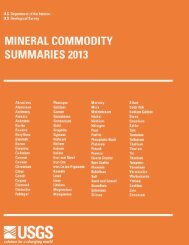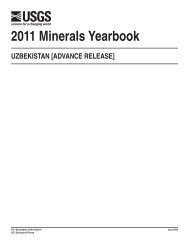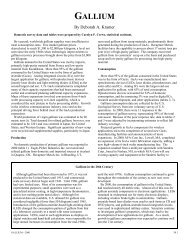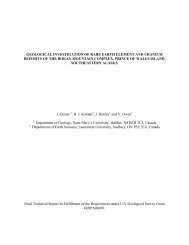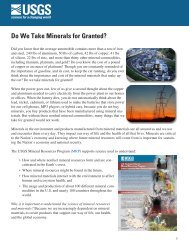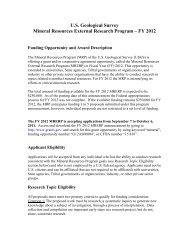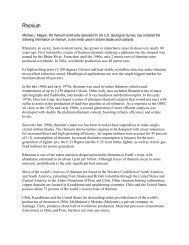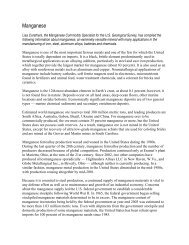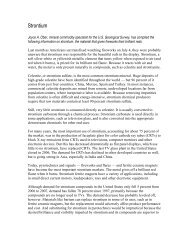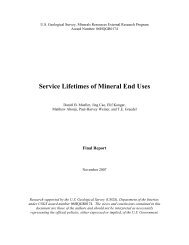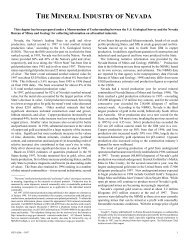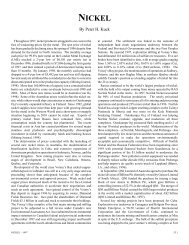Mineral Commodity Summaries 2003 - Mineral Resources Program ...
Mineral Commodity Summaries 2003 - Mineral Resources Program ...
Mineral Commodity Summaries 2003 - Mineral Resources Program ...
You also want an ePaper? Increase the reach of your titles
YUMPU automatically turns print PDFs into web optimized ePapers that Google loves.
CLAYS<br />
Tariff: Item Number Normal Trade Relations<br />
12/31/02<br />
Kaolin and other kaolinitic clays,<br />
whether or not calcined 2507.00.0000 Free.<br />
Bentonite 2508.10.0000 Free.<br />
Fuller’s and decolorizing earths 2508.20.0000 Free.<br />
Fire clay 2508.30.0000 Free.<br />
Common blue and other ball clays 2508.40.0010 Free.<br />
Other clays 2508.40.0050 Free.<br />
Chamotte or dina’s earth 2508.70.0000 Free.<br />
Activated clays and earths 3802.90.2000 2.5% ad val.<br />
Expanded clays and mixtures 6806.20.0000 Free.<br />
Depletion Allowance: Ball clay, bentonite, fire clay, fuller’s earth, and kaolin, 14% (Domestic and foreign); clay used<br />
in the manufacture of common brick, lightweight aggregate, and sewer pipe, 7.5% (Domestic and foreign); clays used<br />
in the manufacture of drain and roofing tile, flower pots, and kindred products, 5% (Domestic and foreign); clay used<br />
for alumina and aluminum compounds, 22% (Domestic).<br />
Government Stockpile: None.<br />
Events, Trends, and Issues: The amount of clay and shale sold or used by domestic producers increased slightly in<br />
2002. Increases were reported for the production of common clay and shale and fuller’s earth. Imports for<br />
consumption increased 51% to 224,000 tons in 2002. The largest increase was in imports of kaolin from Brazil.<br />
Brazil, Mexico, and the United Kingdom were the major sources for imported clays. Exports increased slightly to 4.9<br />
million tons in 2002. Canada, Finland, Japan, the Netherlands, and Taiwan were major markets for exported clays.<br />
World Mine Production, Reserves, and Reserve Base: The 2001 production estimates have been revised for<br />
Brazil (kaolin), Germany (kaolin), and Greece (bentonite) based on new information from those countries. Reserves<br />
and reserve base are large in major producing countries, but data were not available.<br />
Mine production<br />
Bentonite Fuller’s earth Kaolin<br />
2001 2002 e<br />
2001 2002 e<br />
2001 2002 e<br />
United States (sales) 4,290 4,110 2,890 3,400 8,110 7,450<br />
Brazil (beneficiated) — — — — 1,800 1,800<br />
Czech Republic (crude) 250 — — — 5,500 5,500<br />
Germany (sales) 500 500 500 500 3,770 3,770<br />
Greece (crude) 1,150 1,150 — — 60 60<br />
Korea, Republic of (crude) — — — — 2,380 2,380<br />
United Kingdom (sales) — — 140 140 2,400 2,400<br />
Former Soviet Union (crude) 6<br />
750 750 — —<br />
7 5,800<br />
7 5,800<br />
Other countries 3,560 3,500 360 350 14,300 14,000<br />
World total (rounded) 10,500 10,000 3,890 4,390 44,100 43,200<br />
World <strong>Resources</strong>: Clays are divided for commercial purposes into ball clay, bentonite, common clay, fire clay, fuller’s<br />
earth, and kaolin. <strong>Resources</strong> of these types of clay are extremely large except for lesser resources of high-grade ball<br />
clay and sodium-bentonite. <strong>Resources</strong> of kaolin in Georgia are estimated to be 1.4 billion tons.<br />
Substitutes: Limited substitutes and alternatives, such as calcium carbonate and talc, are available for filler and<br />
extender applications.<br />
e<br />
Estimated. E Net exporter. NA Not available. — Zero.<br />
1<br />
Excludes Puerto Rico.<br />
2<br />
Refractory uses only.<br />
3<br />
Data may not add to total shown because of independent rounding.<br />
4<br />
Data on stocks are not available and are assumed to be zero for apparent consumption and net import reliance calculations.<br />
5<br />
Defined as imports - exports + adjustments for Government and industry stock changes.<br />
6<br />
As constituted before December 1991.<br />
7<br />
Uzbekistan produced approximately 5.5 million tons of kaolin in 2001 and 2002.<br />
U.S. Geological Survey, <strong>Mineral</strong> <strong>Commodity</strong> <strong>Summaries</strong>, January <strong>2003</strong><br />
51



